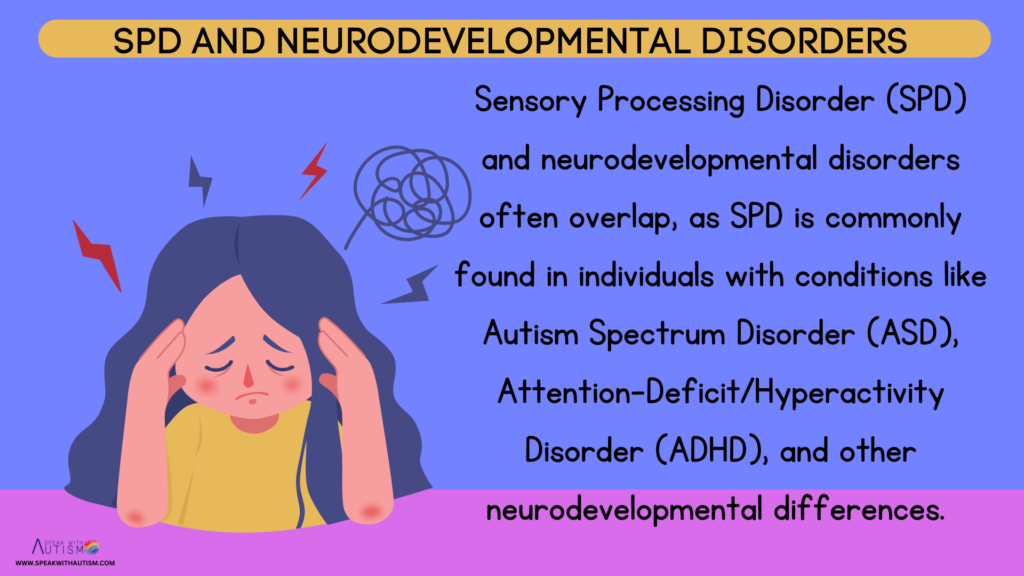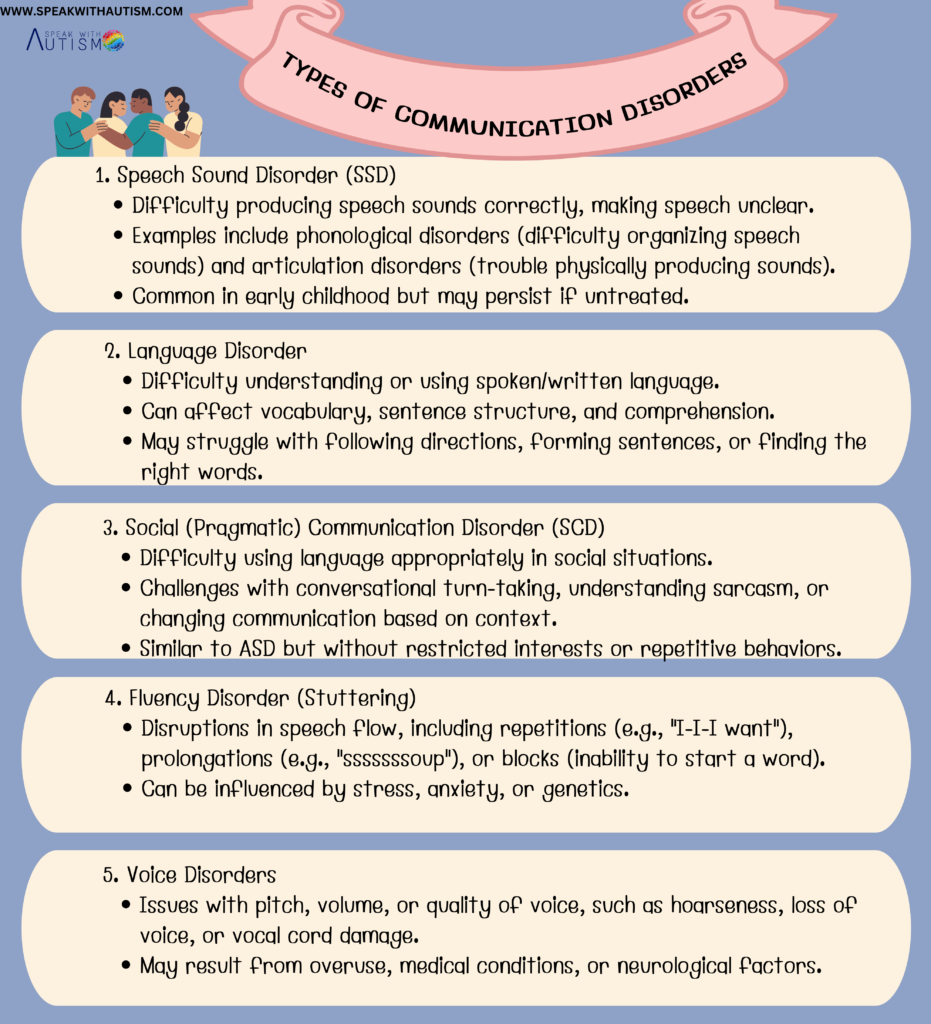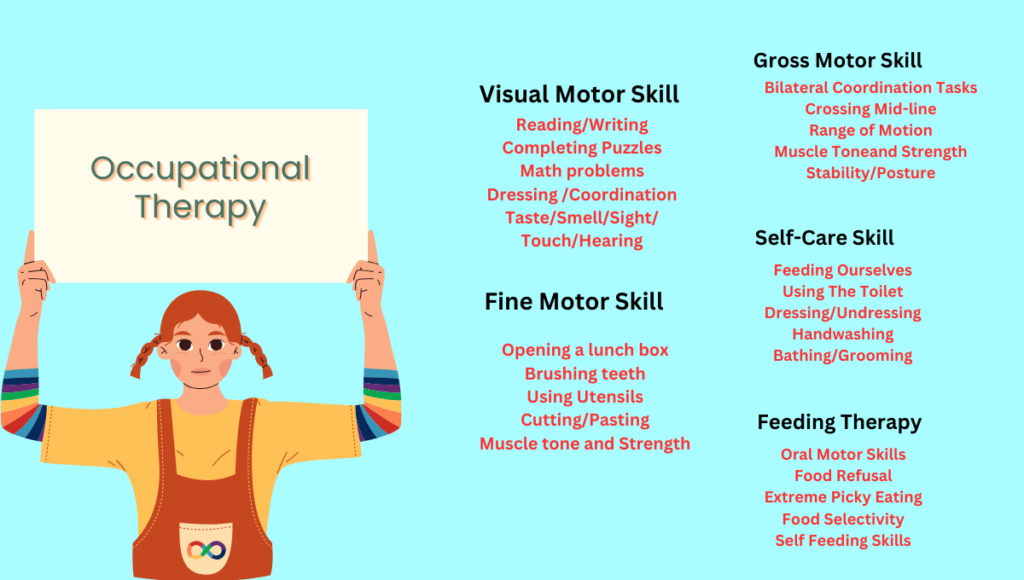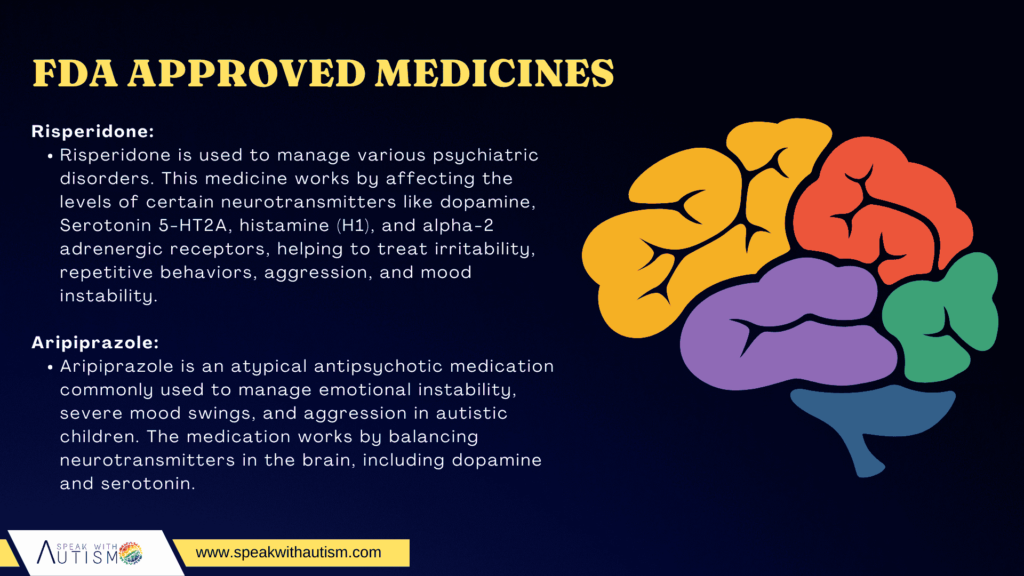SPD and Neurodevelopmental Disorders: Sensory Processing Disorder (SPD) is a condition in which the brain cannot process sensory information (such as seeing, balancing, focusing, hearing, eating, smelling, and touching) properly. Therefore a person reacts either too much (hypersensitive) or too little (hyposensitive) to sensory input such as light, touch, texture, etc., due to which many behavior issues are seen like inability to interact socially, impulsive behavior, communication problems, etc.

Table of Contents
Is SPD a Neurodevelopmental Disorder?
SPD is not officially included as a separate neurodevelopmental disorder in the Diagnostic and Statistical Manual of Mental Disorders (DSM-5). However, many researchers and experts consider it to be a part of a neurodevelopmental disorder or an associated condition.
✅Relation of SPD with other Neurodevelopmental Disorders
SPD characters are seen with these disorders:
1. Autism Spectrum Disorder (ASD)
Many people with SPD are on the autism spectrum. For example, if I talk about my son when he was 2.5 years old, he had a lot of sensory issues like responding more to sound, touching issues, balancing issues, taste, and smell issues. Autism is a spectrum disorder, which means that each autistic person is affected in different ways. Earlier different types of autism were defined, such as:
- Autistic Disorder (Classic Autism)
- Asperger Syndrome
- Pervasive Developmental Disorder – Not Otherwise Specified (PDD-NOS)
But in DSM-5 (Diagnostic and Statistical Manual of Mental Disorders, 5th edition) all types were combined and given one name: “Autism Spectrum Disorder (ASD)“. This means that different types of autism are placed in the same spectrum, but the severity and symptoms can be different.
2. ADHD (Attention-Deficit/Hyperactivity Disorder)
People with ADHD also face sensory issues. ADHD (attention deficit hyperactivity disorder) symptoms (hyperactivity, inattention, impulsivity) can make life challenging but are not typically considered dangerous. Most ADHD children experience challenges in the following areas:
- Difficulty in focus: Children with ADHD find it difficult to concentrate.
- Hyperactivity and impulsivity: These children are more active and react immediately without thinking.
- Lack of patience: It is difficult for them to spend a long time on anything.
3. Specific Learning Disorders (SLD)
Children with SPD often have learning difficulties. Although not every person with SPD is affected by autism or ADHD, sensory issues are common in both conditions. In this, children have the following types of problems:
- Dyslexia: Difficulty in reading and writing.
- Dyscalculia: Math-related problems.
- Dysgraphia: Problems with writing and hand coordination.
4. Intellectual Disability (ID)
Most children have problems with learning and problem-solving skills, understanding common things, and performing daily activities. Therefore, children may find it difficult to learn independent skills.
5. Communication Disorders

There is difficulty in talking, listening, understanding, or speaking correctly. Children are unable to explain the proper rhythm of a sentence. They are unable to understand where to place most of the words but with consistent practice, they learn it.
- Speech sound disorder, language disorder, and stuttering (haklana) are included in this.
6. Motor Disorders
- Developmental Coordination Disorder (DCD): In this, persons have problems with physical movements and balance.
- Tourette Syndrome: Uncontrollable movements or sounds (tics).
Treatment and Management of SPD
Occupational Therapy (OT)
In Occupational therapy, work is done on the independent skills of the child, it is basically work done on the fine muscles and gross motor skills of the child such as zipping unzipping, jumping, sliding, balancing buttoning -unbuttoning, deep massages on muscles, exercises with a gym ball, cricket, catch ball throw, hitting ball, kickball, etc. all these activities are done in outdoor activities such as cricket, throwing and catching a ball, badminton, kho-kho, tug of war, slides, and swings are included as a part of the therapy.

Sensory Diet
Sensory Integration Therapy improves the way the brain processes sensory input. Specific activities that balance sensory needs. In sensory integration therapy children engage with various textures, light, and sound to meet their unique sensory needs. Techniques include deep pressure using gym balls, light-up toys for visual stimulation, sensory mats, specialized sensory equipment, and watercolors to help reduce tactile sensitivity. These activities help minimize unwanted behaviors by addressing the sensory challenges the child may face.
Medication Management

Actually, there is no treatment for sensory processing disorder. Apart from therapies, children are also given medical treatment. Some labeled and non-label medicines are used for the treatment of sensory processing disorder. Label medicines are those that the FDA approves and non-label medicines are those that are given to reduce behavioral and gastrointestinal issues in children. Apart from this, MeRT treatment is also a new approach to the treatment of autism.
Causes of Neurodevelopmental Disorders
- Genetics (heredity): Risk increases if there is a family history.
- Problems in Brain Development: Complications during pregnancy or birth.
- Environmental Factors: Pollution, stress, toxins, or infections.
- Premature Birth: Risk is higher in children born before time.
Decision: SPD and Neurodevelopmental Disorders
SPD is not officially considered a neurodevelopmental disorder, but it is related to and overlaps with many neurodevelopmental conditions. Because of this, SPD is considered a separate sensory disorder that often co-exists with other neurological or developmental disorders.
Frequently Asked Questions (FAQ’s)
What is a Neurodevelopmental disorder?
Neurodevelopmental disorder is a group of conditions caused by problems during brain development. These disorders appear in childhood and affect learning, behavior, social skills, memory, communication, and motor skills such as fine motor, gross motor, and oral motor skills.
These problems can be caused by genetics, environmental factors, abnormal brain development, premature birth, or exposure to toxins. Their effect can be different for each individual—some have mild symptoms, while others have a severe impact.
Can neurodevelopmental disorders be cured?
The neurodevelopmental disorder can be a lifelong condition, but with the right therapy, education, and support people can live their lives well. Every individual is different, so early diagnosis and the right intervention are very important.
